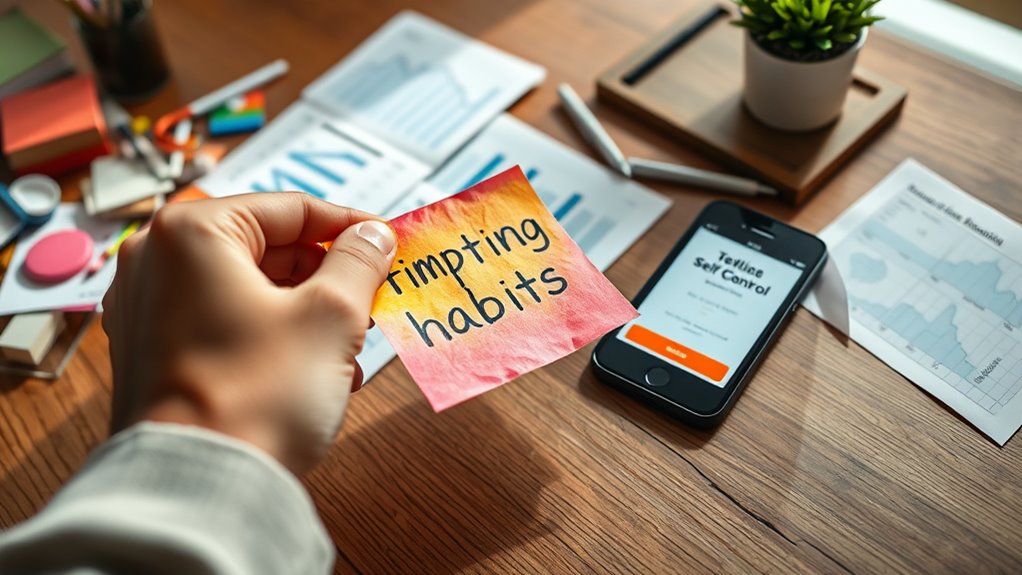To break bad habits, you need to understand how your brain’s reward systems reinforce them through dopamine and triggers. Use behavioral economics strategies like replacing unhealthy rewards with healthier ones and planning responses to common triggers. Rewiring neural pathways takes consistent effort and strategic changes that focus on self-control, not just willpower. Keep exploring ways to reprogram your habits, and you’ll discover more effective techniques to create lasting change.
Key Takeaways
- Leverage behavioral economics by redesigning environments to reduce triggers and make healthy choices easier.
- Use self-control strategies like implementation intentions and commitment devices to strengthen habit change efforts.
- Replace unhealthy rewards with healthier alternatives that satisfy the brain’s craving for relief or pleasure.
- Anticipate triggers and plan specific responses to disrupt automatic habit loops effectively.
- Understand the reward system’s role in habit formation to rewire neural pathways and foster lasting change.

Breaking bad habits can feel overwhelming, but understanding how they form is the first step to change. When you look at habit formation, you’ll notice it’s a process deeply rooted in your brain’s reward systems. Every time you perform a behavior that offers some form of pleasure or relief, your brain records this as a positive experience, encouraging you to repeat it. Over time, these repeated actions become automatic, driven by cues and triggers that you might not even be fully aware of. This cycle is reinforced by your brain’s reward system, which releases chemicals like dopamine whenever you engage in a habit, making it feel satisfying and reinforcing the behavior. Recognizing this connection is vital because it shows that breaking bad habits isn’t just about willpower; it involves rewiring the reward mechanisms that keep those habits alive.
Understanding how habits form reveals they are driven by reward systems, making change possible through rewiring brain responses.
Once you understand that habits are sustained by reward systems, you can start to manipulate those systems to your advantage. Instead of simply trying to suppress the urge to perform a bad habit, you can replace or modify the reward associated with it. For instance, if you tend to snack mindlessly when stressed, you might replace that with a healthier reward—like taking a short walk or practicing deep breathing. By doing so, you’re still satisfying your brain’s craving for relief or pleasure, but in a way that aligns with your goals. This shift helps weaken the original habit loop, making it easier to form new, healthier routines. It’s important to be patient, because the habit formation process involves creating new neural pathways that compete with existing ones, which takes time and consistent effort.
Furthermore, understanding the role of reward systems can help you anticipate triggers and plan your responses. If you know that certain environments or emotions activate your desire for a bad habit, you can prepare alternative actions that provide a similar reward. For example, if boredom triggers your urge to binge-watch shows excessively, you might set a timer to limit screen time or engage in a more fulfilling activity that offers a sense of accomplishment or relaxation. Additionally, choosing appropriate health-related products like specialized shampoos or oils can support your overall well-being and reinforce positive habits. Over time, these strategic changes help reprogram your reward system, making it easier to resist old habits and develop new, healthier ones.
In essence, breaking bad habits isn’t about sheer willpower alone; it’s about understanding and reconfiguring the reward systems that sustain those habits. When you recognize how habits are formed and reinforced, you gain the power to disrupt the cycle and create lasting change.
Frequently Asked Questions
How Do Habits Form in the Brain From a Behavioral Economics Perspective?
Habits form in your brain when neural pathways strengthen through repeated behaviors, making actions automatic. From a behavioral economics perspective, your reward systems play a key role, as they reinforce behaviors that bring immediate pleasure or relief. Each time you engage in a habit, dopamine releases, strengthening neural pathways and making it more likely you’ll repeat the behavior. Over time, this creates a loop that solidifies habits in your brain.
What Role Do Incentives Play in Breaking Bad Habits Effectively?
Incentives play a pivotal role in breaking bad habits by leveraging reinforcement mechanisms to motivate change. When you align incentives with positive behaviors, you increase the likelihood of sticking to new routines. Effective incentive alignment makes healthier choices more rewarding, helping you override old patterns. By adjusting rewards and consequences, you create a compelling environment that encourages you to break bad habits and develop lasting, beneficial behaviors.
Can Self-Control Be Improved Through Specific Behavioral Strategies?
Can you boost your self-control with targeted strategies? Absolutely. You can strengthen willpower reinforcement by setting clear goals and practicing mindfulness, which helps resist temptations. Habit reversal techniques, like replacing bad habits with healthier ones, also work wonders. These behavioral strategies make self-control more sustainable, making it easier to break bad habits. Isn’t it worth trying proven methods to regain control and improve your habits over time?
How Do Environmental Cues Influence the Development of Bad Habits?
Environmental cues and context triggers strongly influence your bad habits by often signaling when to act without conscious thought. For example, seeing a snack jar might prompt you to snack mindlessly, or stress at work could trigger procrastination. These cues activate habitual responses, making it harder to resist temptations. To break this cycle, identify and modify these environmental triggers, creating new cues that promote healthier behaviors and weaken old, unwanted habits.
What Are Common Pitfalls When Trying to Change Ingrained Behaviors?
You might bite off more than you can chew, which is a common pitfall when trying to change ingrained behaviors. Habit reversal requires consistent effort, but motivation barriers often trip you up. You may underestimate the difficulty or rely on willpower alone, leading to setbacks. To succeed, set realistic goals, build new routines, and stay patient. Remember, change takes time, and persistence pays off even when progress feels slow.
Conclusion
By understanding how your habits form and leveraging behavioral economics, you can outsmart your impulses. The theory suggests that small changes and strategic choices can markedly reshape your behavior over time. Remember, self-control isn’t just about sheer willpower—it’s about designing your environment to make good habits easier and bad habits harder. Trust that consistent effort, combined with smart strategies, can truly break your bad habits and build lasting positive change.









